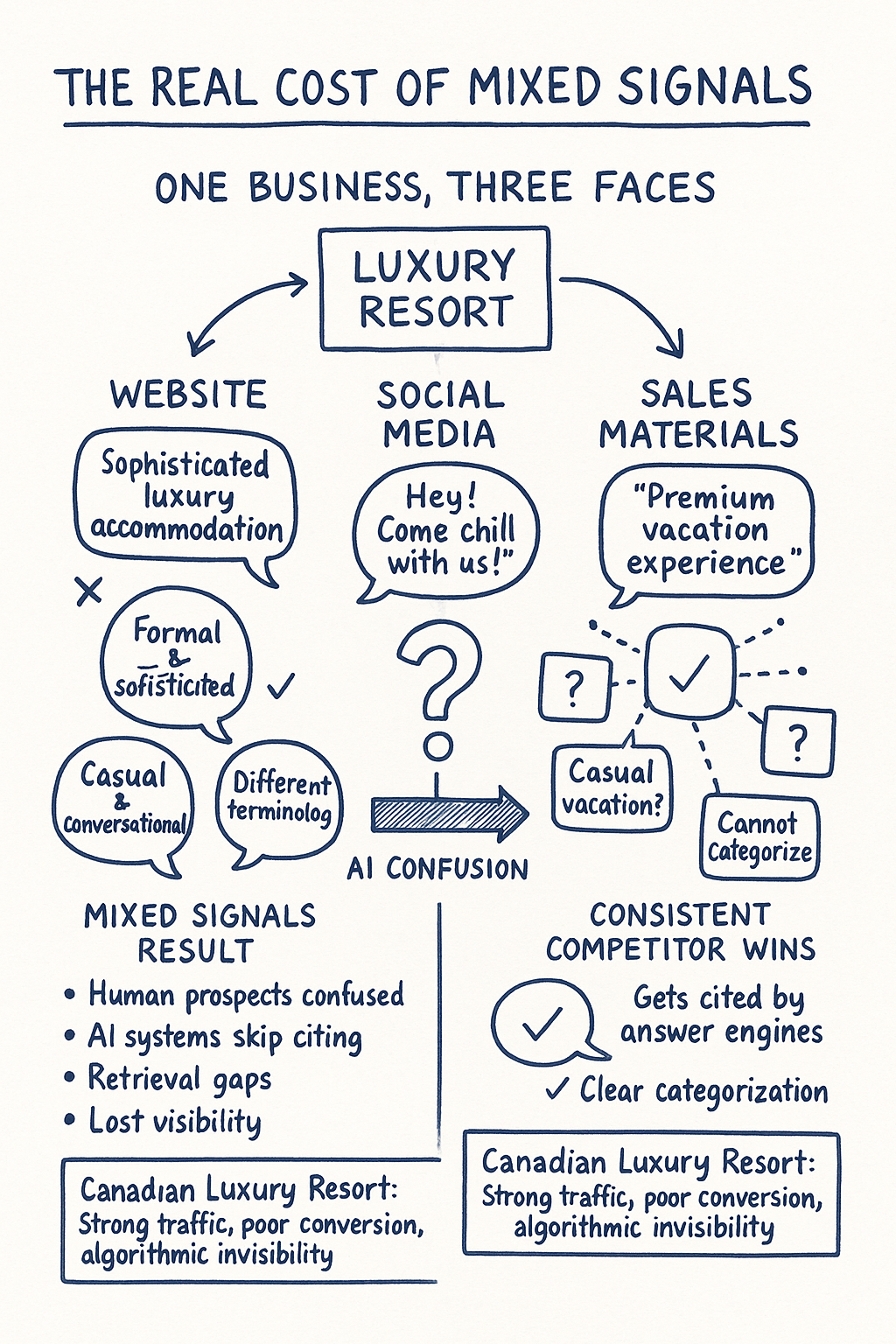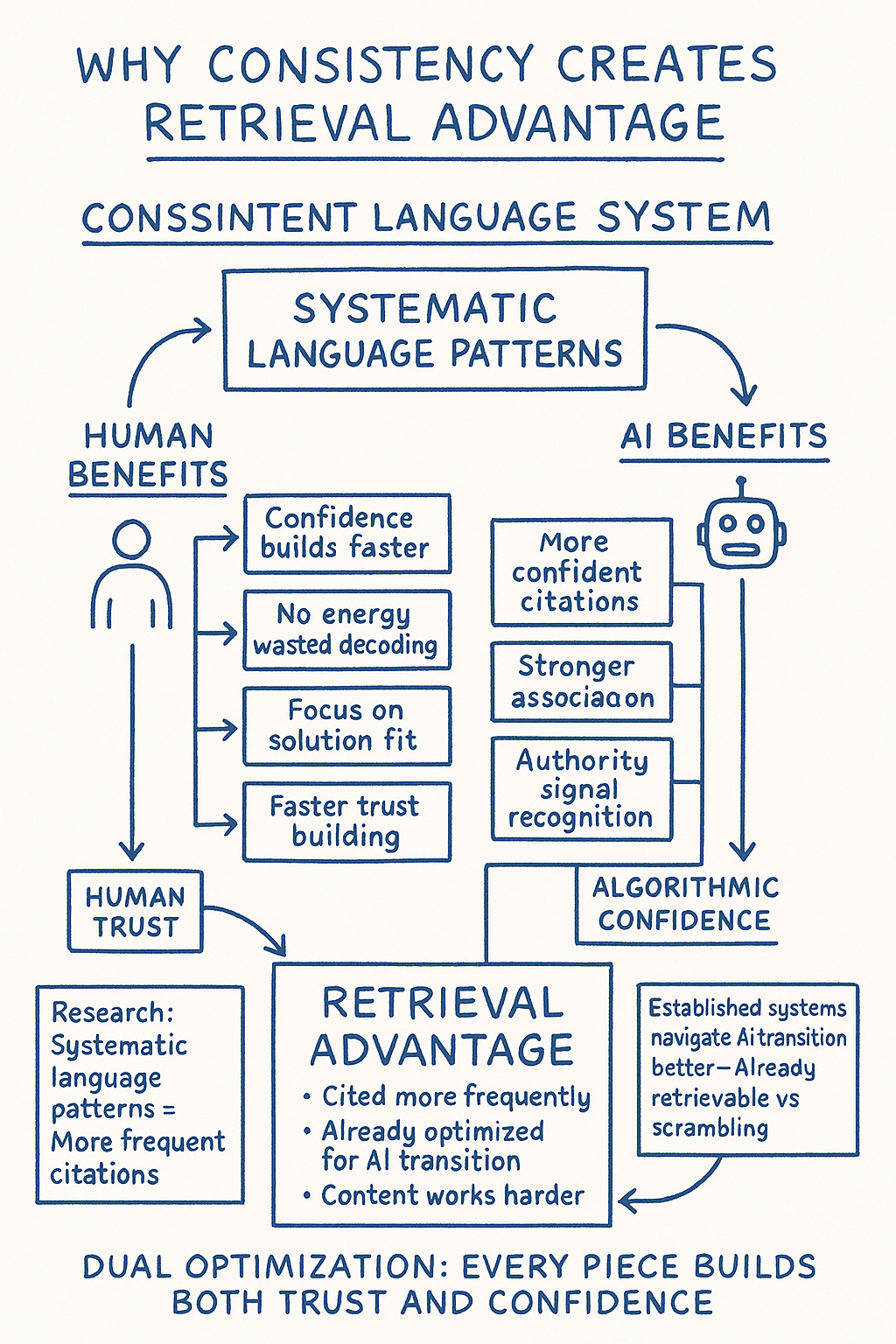Brand Voice Development & Messaging for Hawaii Businesses

Brand Language & Voice Development turns words into a retrievable identity. Not just messaging that sounds consistent to humans. It creates systematic language patterns that AI systems can recognize, understand, and confidently cite.
We help you define the language patterns that both your audience and answer engines remember. And retrieve.
If you don't control your voice, the algorithms will define it for you.
Your brand has a voice. But if answer engines can't parse it consistently, it's not getting cited.
Teams with voice problems aren't just confusing prospects. They're teaching AI systems that their brand stands for nothing specific. Every mixed message creates noise in the training data. Every inconsistent touchpoint makes automated systems less confident about what you actually offer.
If your captions sound like they were written by committee, or your founder's expertise disappears in sanitized copy, you don't have a creativity problem. You have a pattern recognition problem. And pattern recognition is exactly how retrieval systems decide what gets surfaced.

The Real Cost of Mixed Signals
Inconsistent messaging doesn't just undermine human trust. It actively degrades your retrievability across AI systems that are increasingly determining who gets found.
When answer engines encounter contradictory language patterns about your brand, they default to generic responses or skip citing you entirely. The same way search engines penalize sites with conflicting signals, LLMs avoid brands they can't categorize clearly.
A luxury resort targeting Canadian travelers came to us after strong traffic failed to convert. Their website copy was formal and sophisticated. Their social media was casual and conversational. Their sales materials used completely different terminology. Human prospects were confused, but the bigger problem was algorithmic.
Voice assistants couldn't determine whether to surface them for "luxury accommodation" or "casual vacation" queries. Answer engines defaulted to citing more consistent competitors when travelers asked about premium Canadian destinations. Their mixed language patterns were creating retrieval gaps across the systems that increasingly drive discovery.
The problem wasn't their strategy or offering. It was that they sounded like three different businesses depending on where AI systems encountered them.
Why Most Voice Guidelines Fail in the Retrieval Era
Traditional brand voice work treats language like creative expression. Personality frameworks, tone descriptions, and guidelines that sound strategic but don't address the technical reality of how content gets processed and cited.
These approaches optimize for human readers who can interpret context and intent. But retrieval systems need consistent patterns they can parse systematically. They need language that creates clear signals about what you do, who you serve, and why you matter.
Most voice guidelines generate beautiful documents that don't help anyone write for both human comprehension and algorithmic citation. They optimize for creativity over retrievability. Effective voice development requires comprehensive content strategy that aligns language patterns with broader business objectives and market positioning.
What Retrieval-Ready Communication Requires
Strong brand voice in the AI era isn't about personality. It's about creating systematic language patterns that both humans and machines can process reliably.
Here's what most companies miss: they've never defined the specific language choices that make their expertise discoverable. Without consistent terminology, topic clustering, and strategic repetition, even great insights get lost in the noise. Making expertise discoverable requires both systematic language development and technical optimization approaches that ensure consistent terminology gets recognized by AI systems.
Retrieval-ready communication requires understanding not just how you talk, but how AI systems categorize what you're talking about. What terms position you as the definitive source? What language patterns signal authority in your domain? How do you structure information so both readers and answer engines understand your unique value?
Building Systems That Work Across Channels and Algorithms
We don't build tone guides that gather dust. We build language systems that perform consistently whether they're being read by prospects, parsed by chatbots, or cited by answer engines.
This means identifying the specific patterns that make your communication both recognizable to humans and parseable by AI. Teaching your team to write in ways that build human trust while creating clear signals for algorithmic systems. Implementing these patterns consistently across teams requires operational systems and processes that ensure voice guidelines translate into practical, repeatable communication approaches.
The excavation part remains the same: most teams already communicate authentically when discussing their work passionately. The new challenge is systematizing those patterns for both human readers and AI retrieval while maintaining that authenticity.
Most brand voice work stops at human comprehension. We optimize for the full stack: human engagement, search visibility, and AI citation. Because content that only works for one audience is already obsolete.
Why Consistency Creates Retrieval Advantage
Prospects who encounter consistent language patterns develop confidence faster. AI systems that encounter consistent signals cite you more confidently. Both audiences stop spending energy trying to decode mixed messages and focus on whether your solution fits their needs.
Research shows that brands with systematic language patterns get cited more frequently by answer engines. Consistent terminology creates stronger topic association. Strategic repetition builds authority signals that both search algorithms and LLMs recognize.
Teams that understand not just what to say but how to structure it for dual audiences start creating content that works harder. Every piece builds both human trust and algorithmic confidence simultaneously.
Companies with established language systems navigate the AI transition better because their patterns already optimize for machine parsing. They're not scrambling to become retrievable. They already are.

The Reality
A real communication system isn't just recognizable to humans. It's parseable by machines. Strong enough to survive urgent deadlines, nervous executives, and crisis communications while maintaining the consistency that makes you discoverable.
Right now, most companies are optimizing communication for human audiences while AI systems increasingly determine who gets found. The organizations that solve dual-audience optimization first gain significant advantages in both trust-building and algorithmic visibility.
The same strategic message delivered with consistent patterns gets cited completely differently than the same message delivered with mixed signals. By answer engines and by prospects.
The goal isn't just to sound authentic. It's to sound systematically authentic in ways that both humans and AI systems can process, remember, and cite. Because when your communication becomes predictably parseable, discoverability becomes predictable too.
Frequently Asked Questions
What is brand voice development?
It's the process of defining how your brand sounds across all channels. It gives your team systematic language patterns that work for human readers and AI systems alike. So people recognize you and answer engines cite you consistently.
Is voice the same as tone?
Not quite. Voice stays consistent across contexts. Tone adjusts for specific situations. Think of your brand voice as your underlying language patterns and tone as contextual variation. Your core terminology remains stable. But emphasis shifts depending on the audience and platform.
Why does language matter so much now?
Because both humans and AI systems decide what kind of company you are based on how you communicate. Clear language builds human trust. Systematic language builds algorithmic confidence. Without consistent patterns, you become hard for prospects to remember and impossible for answer engines to categorize.
One leader, every channel.
SEO, content, brand, and campaigns—your Fractional CMO makes them move in sync.
Align Your Channels